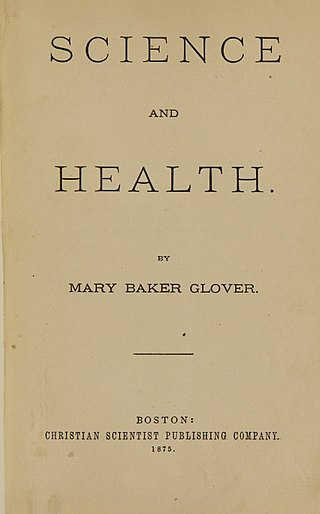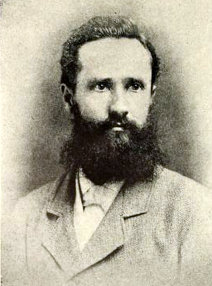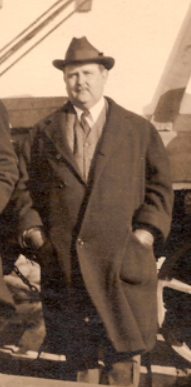
The Church of Christ, Scientist was founded in 1879 in Boston, Massachusetts, by Mary Baker Eddy, author of Science and Health with Key to the Scriptures, and founder of Christian Science. The church was founded "to commemorate the word and works of Christ Jesus" and "reinstate primitive Christianity and its lost element of healing". Sunday services are held throughout the year and weekly testimony meetings are held on Wednesday evenings, where following brief readings from the Bible and the Christian Science textbook, those in attendance are invited to give testimonies of healing brought about through Christian Science prayer. The church rotates so-called "readers", who lead these biblical readings.

Phineas Parkhurst Quimby was an American clockmaker, mentalist and mesmerist. His work is widely recognized as foundational to the New Thought spiritual movement.

Science and Health with Key to the Scriptures is, along with the Bible, the central text of the Christian Science religion. Mary Baker Eddy described it as her "most important work." She began writing it in February 1872 and the first edition was published in 1875. However, she would continue working on it and making changes for the rest of her life.

Mary Baker Eddy was an American religious leader and author who founded The Church of Christ, Scientist, in New England in 1879. She also founded The Christian Science Monitor, a Pulitzer Prize-winning secular newspaper, in 1908, and three religious magazines: the Christian Science Sentinel, The Christian Science Journal, and The Herald of Christian Science. She wrote numerous books and articles, the most notable of which was Science and Health with Key to the Scriptures, which had sold over nine million copies as of 2001.

Christian Science is a set of beliefs and practices associated with members of the Church of Christ, Scientist. Adherents are commonly known as Christian Scientists or students of Christian Science, and the church is sometimes informally known as the Christian Science church. It was founded in 19th century New England by Mary Baker Eddy, who wrote the 1875 book Science and Health with Key to the Scriptures, which outlined the theology of Christian Science. The book became Christian Science's central text, along with the Bible, and by 2001 had sold over nine million copies.

The Destiny of The Mother Church is a book by Bliss Knapp published by Christian Science Publishing Society in 1991. Knapp and his parents, Ira O. and Flavia Stickney Knapp, all knew Mary Baker Eddy. His parents were students of hers and his father was one of the original members of the Board of Directors of The Mother Church. Until 1991, the book was repeatedly rejected for publication by the Christian Science Board of Directors because of the depiction of Eddy as the fulfillment of biblical prophecy and equating her with Christ Jesus, a position which Eddy considered blasphemous. Eddy identified the woman in the Book of Revelation not as a person, but as "generic man". Destiny's publication caused divisions within the church, including several resignations of prominent church employees. Critics claimed that the failure of the church's then-recent television venture, which had cost the church several hundred million dollars, had motivated the Board's reversal on publishing Knapp's book. Knapp, his wife and her sister left wills that granted bequests totalling over $100 million promised to the church if the book were to be published. The wills set a time limit of 20 years for the book to be published, otherwise the bequests were to be divided between Stanford University and the Los Angeles County Museum of Art, and the church would receive nothing. The 1973 death of Knapp's wife set the date of the time limit to May 1993.

Bliss Knapp, the son of Ira O. and Flavia S. Knapp, students of Mary Baker Eddy, was an early Christian Science lecturer, practitioner, teacher and the author of The Destiny of the Mother Church.
Robert Arthur Peel was a Christian Science historian and writer on religious and ecumenical topics. A Christian Scientist for over 70 years, Peel wrote editorials for the Christian Science Monitor, a publication owned by the Church of Christ, Scientist. He was also a counsellor for the church's Committee on Publication, set up by Mary Baker Eddy (1821–1910), the religion's founder, to protect her own and the church's reputation.
The New Thought movement is a spiritual movement that coalesced in the United States in the early 19th century. New Thought was seen by its adherents as succeeding "ancient thought", accumulated wisdom and philosophy from a variety of origins, such as Ancient Greek, Roman, Egyptian, Chinese, Taoist, Vedic, Hindu, and Buddhist cultures and their related belief systems, primarily regarding the interaction among thought, belief, consciousness in the human mind, and the effects of these within and beyond the human mind. Though no direct line of transmission is traceable, many adherents to New Thought in the 19th and 20th centuries claimed to be direct descendants of those systems.
Christian Science is a 1907 book by the American writer Mark Twain (1835–1910). The book is a collection of essays Twain wrote about Christian Science, beginning with an article that was published in Cosmopolitan in 1899. Although Twain was interested in mental healing and the ideas behind Christian Science, he was hostile towards its founder, Mary Baker Eddy (1821–1910).

The Salem witchcraft trial of 1878, also known as the Ipswich witchcraft trial and the second Salem witch trial, was an American civil case held in May 1878 in Salem, Massachusetts, in which Lucretia L. S. Brown, an adherent of the Christian Science religion, accused fellow Christian Scientist Daniel H. Spofford of attempting to harm her through his "mesmeric" mental powers. By 1918, it was considered the last witchcraft trial held in the United States. The case garnered significant attention for its startling claims and the fact that it took place in Salem, the scene of the 1692 Salem witch trials. The judge dismissed the case.
The history of New Thought started in the 1830s, with roots in the United States and England. As a spiritual movement with roots in metaphysical beliefs, New Thought has helped guide a variety of social changes throughout the 19th, 20th, and into the 21st centuries. Psychologist and philosopher William James labelled New Thought "the religion of healthy-mindedness" in his study on religion and science, The Varieties of Religious Experience.
Julius A. Dresser was an early leader in the New Thought movement. Along with his wife Annetta, Dresser was the first proponent of the "Quimby System of Mental Treatment of Diseases", named after Phineas Parkhurst Quimby. Julius and Annetta were also the parents of prolific New Thought author Horatio Dresser, who, along with them, led a long-time dispute against Christian Science founder Mary Baker Eddy over whether she used Quimby's teaching unattributed in her writing.

The Life of Mary Baker G. Eddy and the History of Christian Science (1909) is a highly critical account of the life of Mary Baker Eddy, the founder of Christian Science, and the early history of the Christian Science church in 19th-century New England. It was published as a book in November 1909 in New York by Doubleday, Page & Company. The original byline was that of a journalist, Georgine Milmine, but a 1993 printing of the book declared that novelist Willa Cather was the principal author; however, this assessment has been questioned by more recent scholarship which again identifies Milmine as the primary author, although Cather and others did significant editing. Cather herself usually wrote that she did nothing more than standard copy-editing, but sometimes that she was the primary author.

Rev. Irving Clinton Tomlinson was an American Universalist minister who converted to Christian Science, becoming a practitioner and teacher. For a time, he lived as one of the workers in the household of church founder, Mary Baker Eddy, later writing a book about his experiences called Twelve Years with Mary Baker Eddy.

John Valentine Dittemore was director of The First Church of Christ, Scientist, the Christian Science church, in Boston from 1909 until 1919. Before that he was head of the church's Committee on Publication in New York, and a trustee for ten years of the estate of Mary Baker Eddy (1821–1910), the founder of the church. Dittemore is best known as the co-author, with Ernest Sutherland Bates, of Mary Baker Eddy: The Truth and the Tradition (1932).

James Henry Wiggin was a Unitarian minister. He also worked as an editor and proofreader.
Edwin Franden Dakin (1898–1976) was an American advertising executive and author who wrote a critical biography of Mary Baker Eddy.

Adam Herbert Dickey, was an author, member of the Board of Directors of The First Church of Christ, Scientist, and a secretary to Mary Baker Eddy.

The Christian Science movement is a religious movement within Christianity founded by Mary Baker Eddy that arose in the mid to late 19th century and that led to the founding of The First Church of Christ, Scientist.














